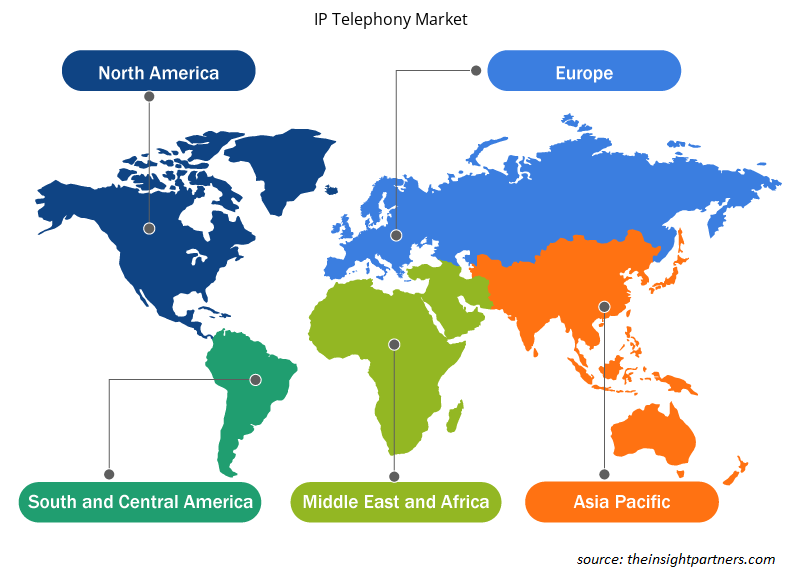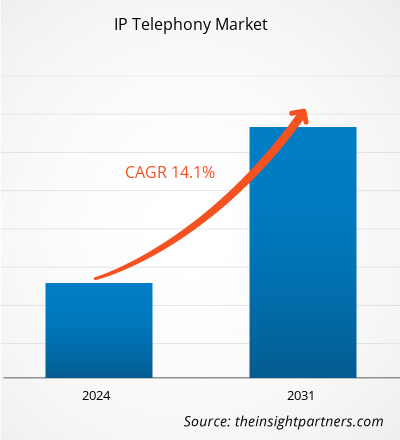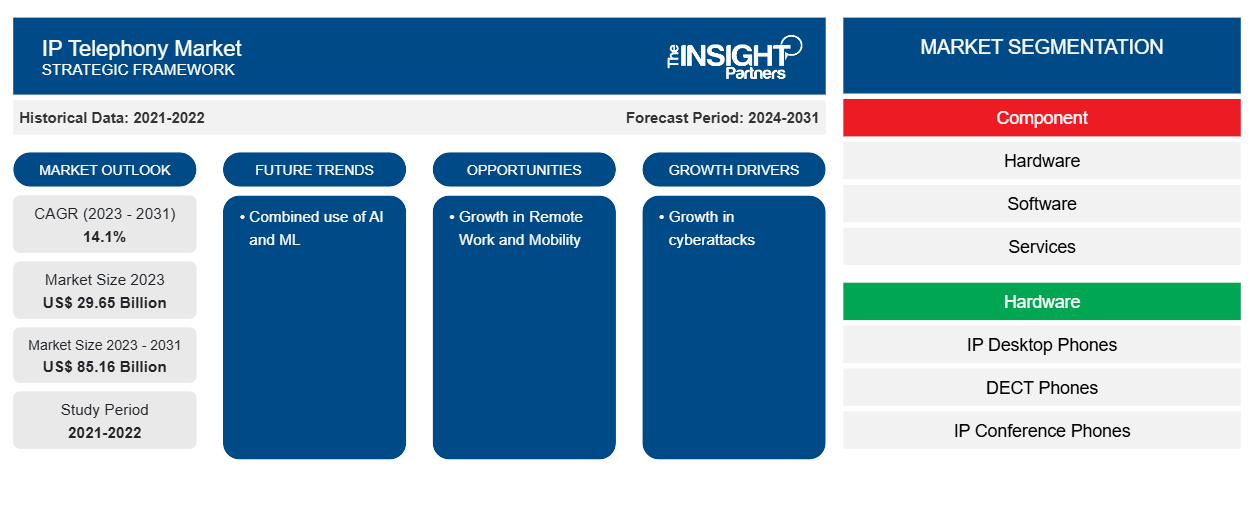Si prevede che la dimensione del mercato della telefonia IP raggiungerà gli 85,16 miliardi di dollari entro il 2031, rispetto ai 29,65 miliardi di dollari del 2023. Si prevede che il mercato della telefonia IP registrerà un CAGR del 14,1% nel periodo 2023-2031. Voice over IP (VoIP) è un servizio e un'applicazione che rientrano nell'ambito della telefonia IP. È la trasmissione di comunicazioni vocali su reti IP.
Analisi del mercato della telefonia IP
La telefonia tramite protocollo Internet (IP) offre una varietà di servizi, come chiamate vocali, videochiamate, posta vocale, fax, messaggistica istantanea (1M) e videoconferenze. La telefonia IP, a differenza di VolP , spesso offre più delle semplici funzioni vocali. La telefonia IP avvantaggia le organizzazioni di tutte le dimensioni fornendo una rete combinata per le funzioni telefoniche e Internet. La telefonia IP offre costi inferiori, infrastruttura più semplice, scalabilità e mobilità, rendendola attraente per gli utenti finali.
Panoramica del mercato della telefonia IP
La telefonia IP si riferisce a qualsiasi sistema che rientra nelle telecomunicazioni basate su Internet, inclusi fax e altre tecnologie. Utilizza una varietà di protocolli open source per inviare dati dal telefono al fornitore di servizi. Le aziende stanno rapidamente implementando soluzioni di telefonia IP per la loro portabilità e convenienza. Inoltre, i sistemi di telefonia IP sono facili da usare, offrono tecnologie avanzate e aumentano la produttività. Questi fattori stanno guidando l'adozione di sistemi di telefonia IP. La telefonia IP aggiunge una nuova funzionalità ai telefoni aziendali e migliora la comunicazione offrendo una soluzione conveniente, che è considerata un fattore chiave per il mercato mondiale della telefonia IP. I sistemi e l'hardware legacy esistenti, come fax , lettori di carte di credito e allarmi, possono essere facilmente collegati ai sistemi telefonici IP.
Personalizza questo report in base alle tue esigenze
Riceverai la personalizzazione gratuita di qualsiasi report, comprese parti di questo report, o analisi a livello nazionale, pacchetto dati Excel, oltre a usufruire di grandi offerte e sconti per start-up e università
-
Scopri le principali tendenze di mercato in questo rapporto.Questo campione GRATUITO includerà analisi di dati che spaziano dalle tendenze di mercato alle stime e alle previsioni.
Driver e opportunità del mercato della telefonia IP
Aumento degli attacchi informatici a favore del mercato
I rapidi progressi tecnologici hanno portato a un aumento delle vulnerabilità negli ultimi anni. Le aziende si affidano sempre di più a prodotti e servizi di telefonia IP, poiché gli attacchi informatici diventano più comuni. IBM stima che il costo totale delle violazioni dei dati nelle aziende sarà di circa 6 trilioni di dollari USA solo nel 2021. Si prevede che i numeri aumenteranno durante il periodo di tempo previsto. Pertanto, le aziende stanno implementando soluzioni di telefonia IP per proteggere i dati e prevenire le violazioni, il che dovrebbe aumentare il CAGR del mercato della telefonia IP durante il periodo di previsione.
Aumento della cultura del lavoro da remoto
L'uso crescente di dispositivi mobili e la crescente adozione di una cultura del lavoro da remoto stanno guidando la domanda di soluzioni di telefonia IP adattive e rapidamente disponibili. I dipendenti utilizzano sempre di più le app per smartphone per effettuare e ricevere chiamate da qualsiasi luogo. Inoltre, la collaborazione da remoto richiede la comunicazione con software di videoconferenza. I provider di telefonia IP si stanno concentrando sullo sviluppo di soluzioni che rispondano a queste esigenze in continua evoluzione.
Analisi della segmentazione del rapporto di mercato sulla telefonia IP
I segmenti chiave che hanno contribuito alla derivazione dell'analisi del mercato della telefonia IP sono componenti, hardware, servizio, tipo di installazione, tipo di impresa e utenti finali.
- In base ai componenti, il mercato della telefonia IP si divide in hardware, software e servizi.
- In base all'hardware, il mercato è segmentato in telefoni IP da tavolo, telefoni DECT e telefoni IP per conferenze.
- In base al servizio, il mercato della telefonia IP si divide in installazione e manutenzione e servizi professionali.
- In base al tipo di installazione, il mercato della telefonia IP è segmentato in cablata e wireless.
- In base alle dimensioni dell'impresa, il mercato della telefonia IP è segmentato in PMI e grandi imprese.
- In base agli utenti finali, il mercato della telefonia IP è segmentato in organizzazioni residenziali, aziendali e governative.
Analisi della quota di mercato della telefonia IP per area geografica
L'ambito geografico del rapporto sul mercato della telefonia IP è suddiviso principalmente in cinque regioni: Nord America, Asia Pacifico, Europa, Medio Oriente e Africa e Sud e Centro America. Le cause coinvolte derivano dall'aumento globale dell'adozione di applicazioni di telefonia IP e dall'avanzamento tecnologico. Queste applicazioni sono spesso create in determinati settori industriali, come BFSI, sanità, vendita al dettaglio, IT e telecomunicazioni. Inoltre, si prevede che la crescita della regione sarà spinta dall'uso diffuso di servizi di telefonia IP, infrastrutture di telecomunicazioni all'avanguardia e dall'attrattiva della mobilità del lavoro.
Approfondimenti regionali sul mercato della telefonia IP
Le tendenze regionali e i fattori che influenzano il mercato della telefonia IP durante il periodo di previsione sono stati ampiamente spiegati dagli analisti di Insight Partners. Questa sezione discute anche i segmenti e la geografia del mercato della telefonia IP in Nord America, Europa, Asia Pacifico, Medio Oriente e Africa e America meridionale e centrale.

- Ottieni i dati specifici regionali per il mercato della telefonia IP
Ambito del rapporto sul mercato della telefonia IP
| Attributo del report | Dettagli |
|---|---|
| Dimensioni del mercato nel 2023 | 29,65 miliardi di dollari USA |
| Dimensioni del mercato entro il 2031 | 85,16 miliardi di dollari USA |
| CAGR globale (2023-2031) | 14,1% |
| Dati storici | 2021-2022 |
| Periodo di previsione | 2024-2031 |
| Segmenti coperti |
Per componente
|
| Regioni e Paesi coperti |
America del Nord
|
| Leader di mercato e profili aziendali chiave |
|
Densità degli operatori del mercato della telefonia IP: comprendere il suo impatto sulle dinamiche aziendali
Il mercato della telefonia IP sta crescendo rapidamente, spinto dalla crescente domanda degli utenti finali dovuta a fattori quali l'evoluzione delle preferenze dei consumatori, i progressi tecnologici e una maggiore consapevolezza dei vantaggi del prodotto. Con l'aumento della domanda, le aziende stanno ampliando le loro offerte, innovando per soddisfare le esigenze dei consumatori e capitalizzando sulle tendenze emergenti, il che alimenta ulteriormente la crescita del mercato.
La densità degli operatori di mercato si riferisce alla distribuzione di aziende o società che operano in un particolare mercato o settore. Indica quanti concorrenti (operatori di mercato) sono presenti in un dato spazio di mercato in relazione alle sue dimensioni o al valore di mercato totale.
Le principali aziende che operano nel mercato della telefonia IP sono:
- Italiano: Avaya Inc.
- Cisco Systems Inc.
- Comunicazioni Gigaset
- LG Electronics Inc.
- Società di reti Mitel
- Società Panasonic
Disclaimer : le aziende elencate sopra non sono classificate secondo un ordine particolare.

- Ottieni una panoramica dei principali attori del mercato della telefonia IP
Notizie e sviluppi recenti del mercato della telefonia IP
Il mercato della telefonia IP viene valutato raccogliendo dati qualitativi e quantitativi dopo la ricerca primaria e secondaria, che include importanti pubblicazioni aziendali, dati associativi e database. Di seguito sono elencati alcuni degli sviluppi nel mercato della telefonia IP:
- Broadvoice, un provider di servizi di hosting voice, comunicazioni unificate e trunking SIP, ha vinto il premio Internet Telephony Product of the Year 2022. Negli ultimi 23 anni, il premio ha onorato e riconosciuto prodotti e servizi di comunicazione VoIP e IP.
(Fonte: Broadvoice, comunicato stampa, marzo 2022)
- Pure IP offre comunicazioni vocali globali per le aziende. È ora accessibile tramite il sistema Zoom Phone Provider Exchange. I clienti avranno maggiore libertà con questo programma. Conserverà Pure IP mentre utilizzerà la sua rete di telecomunicazioni in altri luoghi.
(Fonte: Pure IP, Comunicato stampa, aprile 2023)
Copertura e risultati del rapporto sul mercato della telefonia IP
Il rapporto "Dimensioni e previsioni del mercato della telefonia IP (2021-2031)" fornisce un'analisi dettagliata del mercato che copre le seguenti aree:
- Dimensioni e previsioni del mercato della telefonia IP a livello globale, regionale e nazionale per tutti i segmenti di mercato chiave coperti dall'ambito
- Tendenze del mercato della telefonia IP e dinamiche di mercato come driver, vincoli e opportunità chiave
- Analisi dettagliata delle cinque forze PEST/Porter e SWOT
- Analisi del mercato della telefonia IP che copre le principali tendenze del mercato, il quadro globale e regionale, i principali attori, le normative e i recenti sviluppi del mercato
- Analisi del panorama industriale e della concorrenza che copre la concentrazione del mercato, l'analisi della mappa di calore, i principali attori e gli sviluppi recenti per il mercato della telefonia IP
- Profili aziendali dettagliati
- Analisi storica (2 anni), anno base, previsione (7 anni) con CAGR
- Analisi PEST e SWOT
- Valore/volume delle dimensioni del mercato - Globale, Regionale, Nazionale
- Industria e panorama competitivo
- Set di dati Excel
Report recenti
Testimonianze
Motivo dell'acquisto
- Processo decisionale informato
- Comprensione delle dinamiche di mercato
- Analisi competitiva
- Analisi dei clienti
- Previsioni di mercato
- Mitigazione del rischio
- Pianificazione strategica
- Giustificazione degli investimenti
- Identificazione dei mercati emergenti
- Miglioramento delle strategie di marketing
- Aumento dell'efficienza operativa
- Allineamento alle tendenze normative























 Ottieni un campione gratuito per - Mercato della telefonia IP
Ottieni un campione gratuito per - Mercato della telefonia IP